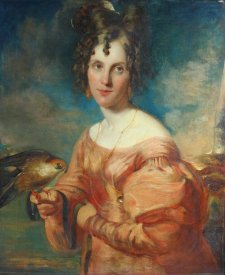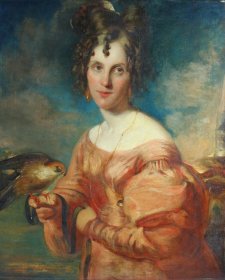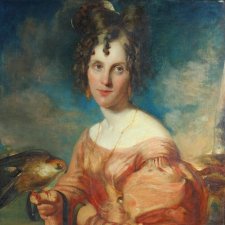- About us
- Support the Gallery
- Venue hire
- Publications
- Research library
- Organisation chart
- Employment
- Contact us
- Make a booking
- Onsite programs
- Online programs
- School visit information
- Learning resources
- Little Darlings
- Professional learning
John Gould (1804–1881) is known as the ‘father of Australian ornithology’ for his Birds of Australia, published in seven volumes between 1840 and 1848. The son of John Gould, a gardener, Gould is believed to have received minimal school education before taking up his father’s profession, working under him at Windsor Castle and subsequently at Kew Gardens and Ripley Castle in Yorkshire. In London from 1825, he established himself in business as a taxidermist and secured clients such as George IV, at whose request he is said to have stuffed the first giraffe sent to England. He married natural history artist Elizabeth Coxen (1804–1841) in 1829, by which time he was working for the Zoological Society of London. The first of his many books, A Century of Birds from the Himalaya Mountains – illustrated with eighty colour plates by Elizabeth – was published in instalments between 1830 and 1832; and was followed by five volumes of The Birds of Europe (1832–37). In classifying the bird specimens collected by Charles Darwin on the voyage of the Beagle, Gould identified thirteen new species of finch, his findings providing crucial evidence in Darwin’s formulation of the theory of evolution and natural selection. In 1838, having commenced researching Australian bird species, Gould decided to see the country’s ‘natural productions’ for himself, and with Elizabeth and their eldest son set out for Tasmania. Gould conducted field work there and in South Australia and New South Wales, sending his assistant to collect specimens in the north west, before returning to England in 1840. Elizabeth died in 1841 following the birth of her eighth child, leaving Gould bereft at the loss of his partner and collaborator and responsible for the care of their six surviving children. Elected a Fellow of the Royal Society in 1843, Gould continued his research, travelling on the Continent and to North America and publishing further multi-volumed works on natural history including Mammals of Australia (1845–1863); Birds of Great Britain (1862–73) and Birds of Asia, the last volume of which appeared posthumously in 1883
Collection: National Portrait Gallery
Purchased 2013



On one level The Companion talks about the most famous and frontline Australians, but on another it tells us about ourselves.



Charting a path from cockatiel to finch, Annette Twyman explores her family portraits and stories.



Visit us, learn with us, support us or work with us! Here’s a range of information about planning your visit, our history and more!